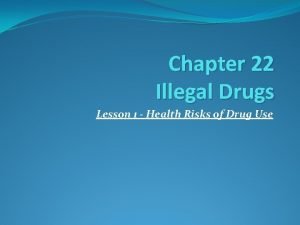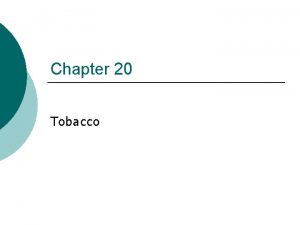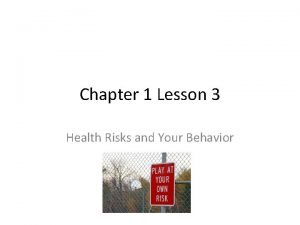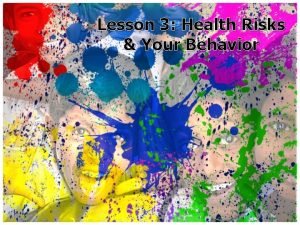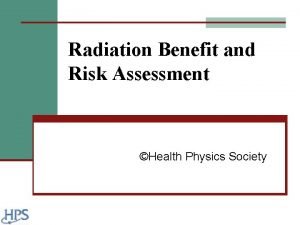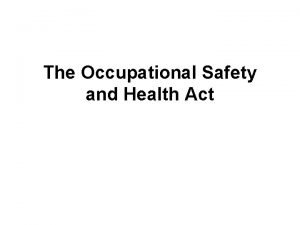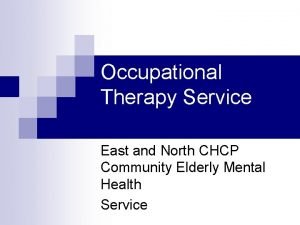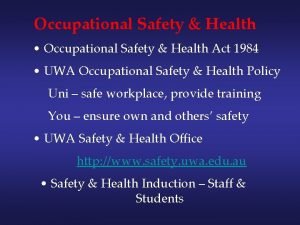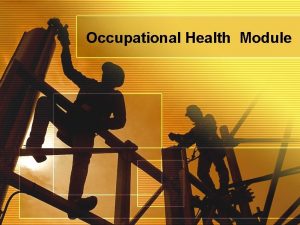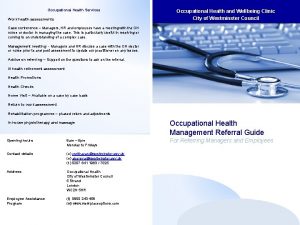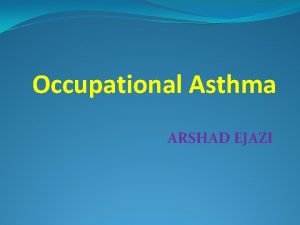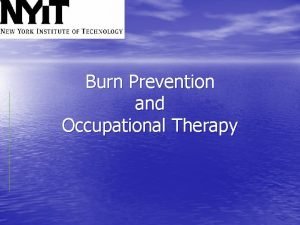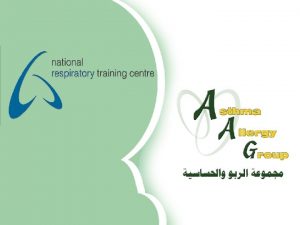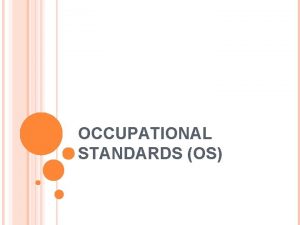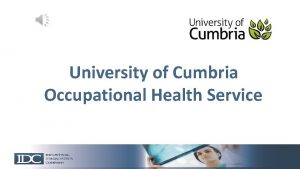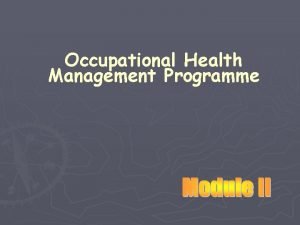Occupational Health Refers to the potential risks to











- Slides: 11


Occupational Health Ø Refers to the potential risks to health and safety for those who work outside the home. Hazard Ø Something that can cause harm if not controlled. Occupational Disease Ø Disease directly caused by a person’s occupation.

OCCUPATIONAL HAZARDS PHYSICAL HAZARDS MECHANICAL HAZARDS CHEMICAL HAZARDS BIOLOGICAL HAZARDS PSYCHOLOGICAL HAZARDS

PHYSICAL HAZARDS Ø Heat – Direct and indirect effect at high temperature, radiant heat, stagnation. Ø Cold – General & Local cold Injury. Ø Light – Acute & Chronic Effect of bright & dim light & Glare Ø Radiation a. Ionizing – X-Rays, Gamma Rays, Beta Particles, Alpha Particles b. Non-Ionizing – Microwaves, infrared and ultra-violet light. Ø Noise – Auditory and non-auditory effects. Ø Vibration – Hazardous in non permit-able frequency range. heat

DISEASE DUE TO PHYSICAL AGENTS DISEASE HEAT Heat Stroke, Heat Hyperpyrexia, Heat Syncope, Heat Rash, Heat Exhaustion. LIGHT Occupational Cataract, Miners nystagmus. COLD Hypothermia, Trench Foot. VIBRATION Osteoarthritis, Reynaud Disease. NOISE Occupational Deafness. PRESSURE Air Embolism, Blast Injuries. RADIATION Cancer, Genetic Changes, Aplastic Anemia.

CHEMICALS HAZARDS Ø Acids Ø Bases Ø Heavy Metals – Lead Ø Solvents - Petroleum Ø Particulates – Asbestos, Silica and other fine dust/fibrous Materials. Ø Fumes – Noxious Gases/vapors. Ø Highly Reactive Materials.

Ways of Acquiring Chemical Hazards A. Local Action : Irritants, Sensitizers. B. Inhalation : Dusts – Organic, Inorganic Gases – Simple Asphyxiantes: Methane, Nitrogen, CO 2. - Chemical Asphyxiants: CO, Hydrogen Sulphide, HCN - Irritant Gases: Ammonia, SO 2 - Anesthetic Gases: Chloroform, Ether C. Ingestion : Metallic Compounds: Arsenic, Antimony, Beryllium, Chromium, Cadmium, Cobalt, Lead, Mercury

Disease due to Chemical Agents Ø Gases – Gas poisoning Ø Inorganic Dusts: Ø Coal Dusts - Anthracosis Silica - Silicosis Asbestos - Asbestosis Iron - Siderosis Inorganic Dusts: Cane Fiber - Bagassosis cotton Dust - Byssinosis Hay Dust Iron - Farmer’s Lung - Siderosis Ø Chemicals – Burns, Dermatitis, Cancer, Respiratory, Illness. Ø Metals – Lead, Mercury, arsenic, Chromium Cause Poisoning

BIOLOGICAL HAZARDS Ø Bacteria –Viruses Ø Fungi – Molds Ø Insects – Mosquitoes Ø Hazardous Plants – Poison Lvy. Ø Birds Ø Animals Ø Blood-Borne Pathogens

Disease due to Biological Agents Ø Hepatitis B Virus Ø Hepatitis C Virus Ø Tuberculosis – Particularly among Healthcare Workers Ø Asthma – Among persons exposed to organic dust Ø Blood-Borne Diseases – HIV/AIDS Ø Anthrax Ø Brucellosis Ø Tetanus Ø Leptospirosis

PSYCHOLOGICAL HAZARDS Ø Work Related Stress – Excess working time and overwork Ø Hepatitis C Virus Ø Violence – From outside the organization Bullying – Emotional and verbal abuse Sexual Harassment Mobbing Burnout Exposure to Unhealthy Elements – Tobacco, Uncontrolled Alcohol
 Occupational health nurse roles and responsibilities
Occupational health nurse roles and responsibilities Chapter 22 lesson 1 the health risks of drug use
Chapter 22 lesson 1 the health risks of drug use Chapter 20 lesson 1 the health risks of tobacco use
Chapter 20 lesson 1 the health risks of tobacco use Chapter 1 lesson 3 health risks and your behavior
Chapter 1 lesson 3 health risks and your behavior Related risks that increase in effect with each added risk
Related risks that increase in effect with each added risk Chapter 1 lesson 3 health risks and your behavior
Chapter 1 lesson 3 health risks and your behavior Health risks
Health risks Lifewave matrix 2
Lifewave matrix 2 Chapter 20 lesson 2 choosing to live tobacco free
Chapter 20 lesson 2 choosing to live tobacco free Osh objectives
Osh objectives Chcp occupational health
Chcp occupational health Occupational safety and health act 1984
Occupational safety and health act 1984

